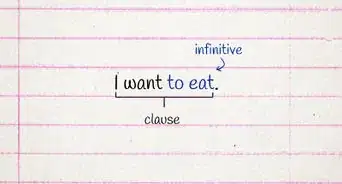This article was co-authored by wikiHow staff writer, Hunter Rising. Hunter Rising is a wikiHow Staff Writer based in Los Angeles. He has more than three years of experience writing for and working with wikiHow. Hunter holds a BFA in Entertainment Design from the University of Wisconsin - Stout and a Minor in English Writing.
There are 8 references cited in this article, which can be found at the bottom of the page.
This article has been viewed 315,680 times.
Learn more...
Pneumonoultramicroscopicsilicovolcanoconiosis is the longest word in the English dictionary at 45 letters and it refers to a lung disease caused by inhaling silica dust.[1] While the word may look intimidating, it can be broken down into root words to make it easier to read. If you still have trouble pronouncing it, there are other ways you can hear and learn the word to make it easier for you. Once you learn how to say pneumonoultramicroscopicsilicovolcanoconiosis, you’ll be able to impress your friends by knowing such a long word![2]
Steps
Breaking the Word into Roots
-
1Break the word down into 6 root words. Split the word like, '"pneumono-ultra-microscopic-silico-volcano-coniosis" when you first try to pronounce it so you can work on the individual root words rather than the whole thing. Each root has its own meaning that adds to the definition of the word.[3]
- For example, "pneumono-" meanings “relating to the lungs.”
- You can break the word into further roots if you still have trouble pronouncing the larger chunks. For example, you may break down “microscopic” into the roots “micro” and scopic.”
-
2Start by saying “pneumono” as “new-moh-no.” Remember that the letter P in “pneumono” is silent when you read it out loud. Articulate each syllable of the root so you can sound it out completely.[4]
- You may also use the “mah” sound in place of “moh” depending on how you want to pronounce the word. Either form is correct.
Advertisement -
3Say “ultra” like “ull-truh.” Put the tip of your tongue against your top teeth when you first start pronouncing the root to help make the “ull” sound. Make sure to use short U- and A-sounds, like the words bug or alone, when you say the root out loud or else you won’t pronounce it correctly.[5]
- Even though there is an O before the letter U in the full word, they do not make the “oo” sound since they come from separate roots.
-
4Pronounce “microscopic” like “my-kro-skop-ick.” Make the first O in word long, like the words bone or low, and the second one short, like the words not or lock. Slowly say each syllable out aloud before combining them together.[6]
Tip: Practice piecing the roots into the full word as learn each one so you can work towards pronouncing them all together. For example, practice saying “pneumonoultramicroscopic-” as naturally as possible.
-
5Say “silico” like “sill-ih-koh.” Use the short “ih” sound for each I and the long “oh” sound for the O in the root word. Pronounce the letter C with a hard K-sound, like the words click or catch. Separate each syllable and work through them slowly before putting them together.[7]
-
6Pronounce “volcano” like “vohl-kay-no.” Use the long O-sound, like in the words bone or go, at the start and end of the root. Make a long A-sound in the middle of your word, such as the sound from bay or crazy.[8]
- The pronunciation of the root is the same as the full word volcano.
-
7Finish the word by saying “koh-nee-oh-sis.” Make sure to use a hard C-sound, like the words crab or coil, when you start the final root of the word. Rather than an “eye” or “ih” sound, pronounce the first letter I with an “ee” sound.[9]
-
8Put all of the roots together to say the word. Slowly say all of the root words in order, being careful to pronounce each syllable correctly. As you get more comfortable saying the roots together, combine them together and read the full word aloud. Point at the word and follow along with your finger throughout the pronunciation so you don’t miss any parts.[10]
- All together, the pronunciation will look like, “new-moh-no-ull-truh-my-kro-skop-ick-sill-ih-koh-vohl-kay-no-koh-nee-oh-sis.”
Mastering the Pronunciation
-
1Listen to other people pronouncing the word so you hear how it sounds. Go to an online dictionary and look up the word pneumonoultramicroscopicsilicovolcanoconiosis. When the page with the definition pops up, click the small speaker icon under the word to hear it out loud. You can also find videos online of other people pronouncing the word so you can hear how you should pronounce it.[11]
- Online dictionaries usually have the phonetic pronunciation listed under the word so you can follow along and try pronouncing the word yourself.
-
2Clap with each syllable so you don’t miss any part of the word. Pneumonoultramicroscopicsilicovolcanoconiosis has 19 syllables, and it may be a little difficult to recognize them. Slowly go through the word syllable by syllable and clap as you say each one. The clapping will help you recognize each syllable and keep track of what you already said. Continue working through the word and clapping until you feel confident saying it out loud.[12]
- If you don’t want to clap, point at each syllable on the word as you say it so you can associate what sound to make for each letter.
-
3Try using the word in a sentence to practice reading and saying it. Since pneumonoultramicroscopicsilicovolcanoconiosis isn't a word you can really use in everyday conversation, make up sample sentences to read aloud so you can try reading it. Say the sentence slowly so you don't stumble over the word and practice reading until you feel comfortable saying it all aloud.[13]
- For example, your sentence may read, "After he went hiking near an active volcano, the man developed pneumonoultramicroscopicsilicovolcanoconiosis."
Community Q&A
-
QuestionWhat does pneumonoultramicroscopicsilicovolcanoconiosis mean?
 Community AnswerIt's a disease of the lungs caused by dust or fine particles.
Community AnswerIt's a disease of the lungs caused by dust or fine particles. -
QuestionWhat are the symptoms?
 DonaganTop AnswererIf there are any symptoms, they could include shortness of breath, coughing, fever or a blue tint to the skin.
DonaganTop AnswererIf there are any symptoms, they could include shortness of breath, coughing, fever or a blue tint to the skin. -
QuestionHow many syllables does the longest word in the English dictionary have?
 Community AnswerThere are nineteen syllables in the longest word in the English dictionary: pneumonoultramicroscopicsilicovolcanoconiosis.
Community AnswerThere are nineteen syllables in the longest word in the English dictionary: pneumonoultramicroscopicsilicovolcanoconiosis.
References
- ↑ https://www.dictionary.com/browse/pneumonoultramicroscopicsilicovolcanoconiosis
- ↑ https://dictionary.cambridge.org/dictionary/english/pneumonoultramicroscopicsilicovolcanoconiosis
- ↑ https://www.youtube.com/watch?v=F8PQbCCHhOo&t=20s
- ↑ https://youtu.be/F8PQbCCHhOo?t=37
- ↑ https://www.dictionary.com/browse/pneumonoultramicroscopicsilicovolcanoconiosis
- ↑ https://www.dictionary.com/browse/pneumonoultramicroscopicsilicovolcanoconiosis
- ↑ https://www.dictionary.com/browse/pneumonoultramicroscopicsilicovolcanoconiosis
- ↑ https://www.dictionary.com/browse/pneumonoultramicroscopicsilicovolcanoconiosis
- ↑ https://www.dictionary.com/browse/pneumonoultramicroscopicsilicovolcanoconiosis
About This Article
If you’re a language lover, you may have wondered how to say the longest word in the English dictionary, pneumonoultramicroscopicsilicovolcanoconiosis. To get started, break the word down into its roots. Start with pneumono, which means “relating to the lungs.” Next is ultra, meaning “extremely,” and microscopic, meaning too small to be seen without a microscope. This word describes a disease that’s caused by inhaling fine volcanic silica dust, so the next roots are silico, which refers to the silica particles, and volcano. Finally, coniosis is a word for a condition caused by inhaling dust. Once you’ve broken the word down into its roots, you might find it helpful to break those into individual syllables, such as “new-moh-no” for pneumono and “koh-nee-oh-sis” for coniosis. After you get comfortable pronouncing each root, put them all together to say the whole word. Read on for tips on how to master the pronunciation of pneumonoultramicroscopicsilicovolcanoconiosis through listening and practice!



























































